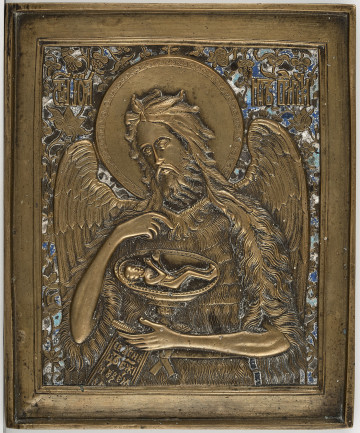
St. John the Baptist
20th century
Castle Museum in Łańcut
Part of the collection: Icons
Crucifixion, silhouette icon. In Greek, 'eikon' means 'image', referring to any depiction. In Eastern Christianity, the word 'eikon' - 'icon' - began to denote sacral depictions and portrayals. Although according to tradition, the oldest depictions came from the time of the Apostles and the Christian writers of the first centuries testified to their existence, in reality, the oldest preserved icons are from the 6th c., from the Saint Catherine's Monastery on Mount Sinai. In the first centuries after the resurrection of Christ, when Christian art was emerging, in the East, the word 'icon' was used for any portrayals of Christ, the Mother of God, Apostles, Evangelists, saints, the Heavenly Powers, biblical scenes, or symbolic depictions relating to the liturgy. In this sense, the displayed cast of a metal cross with a depiction of the crucified Christ is a silhouette relief icon. The tradition of cast objects of Christian worship originates from Byzantium. Products of this type imported to Rus began to be imitated in locally opened manufacturing centres, active since the end of the 11th c. Among the objects of worship in greatest demand were the crosses which accompanied every Christian since birth to death. A cross used as a personal object is hung around the neck and worn close to the body. In Rus, a cross displayed on the chest and visible on the clothes was called 'napiersny'. Napiersny crosses had a loop placed at the back or passing through the crowning. Most often, on the crowning in the front, there is a depiction of Christ's face known as the Mandylion or 'Acheiropoieta' in Greek, meaning 'not created with human hands' (see S.MŁ). In Rus tradition, an eight-pointed cross with three crossbeams became widespread and were more often used, as can be seen on the example of the displayed exhibit (see S.12789MŁ; S.12791-12795MŁ; S.12871-12876MŁ).
Dimensions
height: 9.2 cm, width: 5.3 cm
Object type
Icons
Technique
cast
Material
brass
Origin / acquisition method
decyzja administracyjna
Creation time / dating
Creation / finding place
Owner
Castle Museum in Łańcut
Identification number
Location / status

20th century
Castle Museum in Łańcut

19th (?) century
Castle Museum in Łańcut

1800 — 1850
Castle Museum in Łańcut
DISCOVER this TOPIC
Castle Museum in Łańcut
DISCOVER this PATH
Educational path